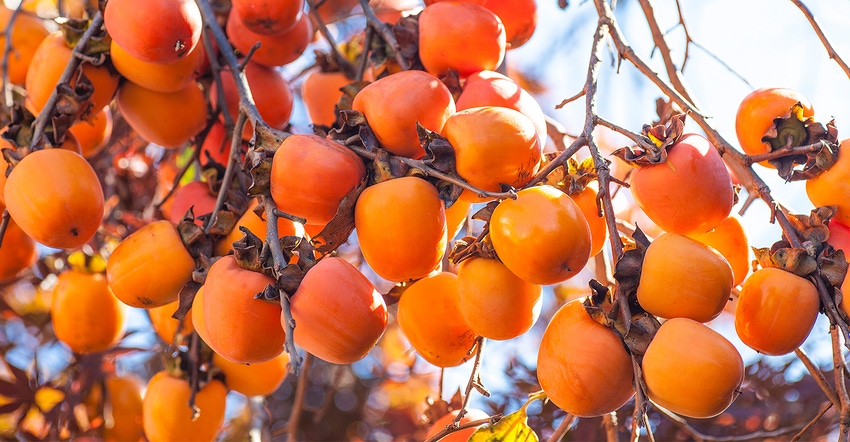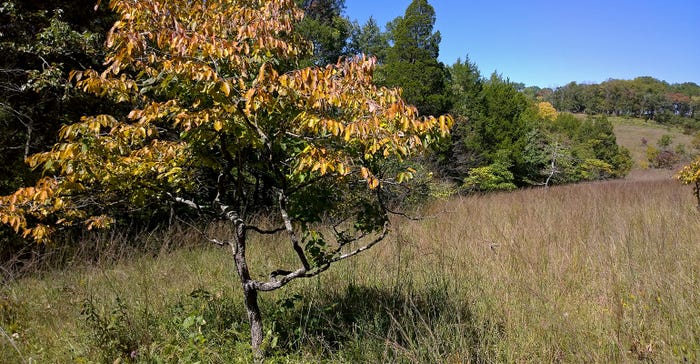August 3, 2018

by Scott Woodbury
Every year, I am required to bake a persimmon pudding on my wife’s birthday. It’s not a chore. It’s a celebration, because we both love moist English puddings — especially persimmon pudding.
The pudding has become an annual tradition, and when we collect extra persimmons we get to enjoy it again and again, because persimmon pulp stores well in the freezer.
Ready for harvest
Persimmons ripen as early as August and continue right through October. Contrary to common lore, persimmons don’t need a cold frost to ripen. They need only fall naturally from the tree or be coaxed by a firm shake of the trunk. Not attached to a broken branch. Not hand-picked from the tree. They must be picked off the ground, preferably fresh, and not mashed.
If you taste a fruit picked off the tree, it likely will bite you back because it still has astringent tannins in it. The tannin dissolves when the fruit is fully ripe, which is when it falls from the tree. Not a day sooner, or your tongue and cheeks will suffer an immediate sensation — like chewing an aspirin. It’s an awful sensation, but quickly fades.

WHERE PERSIMMON GROWS: These fruit trees grow in the wild over much of southern Missouri. Persimmon trees are native to the state, and they grow in full sun or shade. (Photo by Scott Woodbury)

Where to find fruit
Persimmon grows wild in the southern two-thirds of Missouri in a wide array of light and soil conditions, and tolerates full sun or part shade. Permission grows in prairies, along streams and on rocky glades. It typically grows tall and narrow, so it fits into small landscapes. Avoid planting female trees over patios, driveways and buildings, as fallen fruits can make a mess if they aren’t cleaned up.
Its rate of growth is slow or fast, depending on the soil it is growing in, but the trees are known to live a long time. A 15-year-old seedling in Shaw Nature Reserve’s Whitmire Wildflower Garden is 25 feet tall, growing in deep, fertile topsoil. In contrast, a 10-foot tree growing on a rocky sterile glade in the nature reserve is confirmed to be at least 80 years old.
Trees often (but not always) spread by suckering roots into colonies. Male and female flowers exist on separate trees, so be sure to plant multiple seedlings to get at least one of each. Female flowers are about a half-inch wide, and solitary. Male flowers are smaller and appear in pairs. The flowers are noticed on the ground when they fall from the tree like magnolia petals, fresh and white in late spring.
Preparation is key
Fruits of different trees vary widely in size, from tiny with many seeds to plump with few seeds. The larger the fruit, the quicker and easier it is to extract pulp for cooking. Nocturnal mammals of all kinds enjoy eating the fruits — and so do yellow jackets, so be careful when gathering fruits from the ground.
A Foley food mill is useful to separate the seeds from the pulp, making short work of an otherwise tedious, messy and sticky job. Bag the beautiful orange pulp in 1-cup measurements and place in the freezer. The pulp lasts for years this way, if you can resist baking it all at once. The persimmon pudding recipe in the “Fields of Greens” cookbook by Annie Somerville is the best I’ve tasted. It involves slow-baking in a steam bath, which results in a very moist and dense cake. I don’t know why it’s called pudding, but a word of warning: Served with fresh whipped cream, it can become addicting. Bon appétit!
Horticulturist Woodbury is curator of the Whitmire Wildflower Garden at Shaw Nature Reserve in Gray Summit, Mo., where he has worked with native plant propagation, design, and education for 27 years. He also is an adviser to the Missouri Prairie Foundation’s Grow Native! program.
You May Also Like




